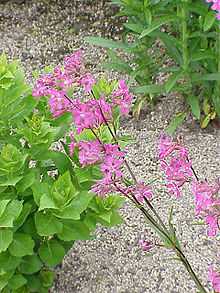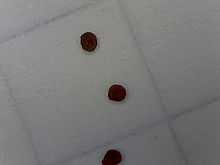Silene viscaria
From Wikipedia, the free encyclopedia
| Silene viscaria | |
|---|---|
 | |
| Scientific classification | |
| Kingdom: | Plantae |
| (unranked): | Angiosperms |
| (unranked): | Eudicots |
| (unranked): | Core eudicots |
| Order: | Caryophyllales |
| Family: | Caryophyllaceae |
| Genus: | Silene |
| Species: | S. viscaria |
| Binomial name | |
| Silene viscaria L. | |
| Synonyms | |
|
Lychnis viscaria | |
Silene viscaria, the sticky catchfly, is a flowering plant in the family Caryophyllaceae.
It is an upright perennial, growing to 60 cm in height. It gets its English name from the stickiness of its stem. It grows on cliffs and in rocky places. It has a purple flower.

Seed, background lines are 5 mm (0.20 in) apart.

Whorl of seed capsules, background lines are 5mm apart.

Seed capsule, viewed from side.

Seed capsule, viewed end on.
Stace[1] and Fitter[2] describe this plant as having the following characteristics:
- Erect perennial to 60 cm (24 in) high.
- Not hairy or only slightly hairy.
- Sticky just below each leaf junction.
- Leaves lanceolate.
- Flowers 20 mm (0.79 in) across; bright rosy red; petals notched; apparently whorled in long spikes; May-August.
Lychnis viscaria is said to increase the disease resistance of surrounding plants. Extract from L. viscaria contains a relatively high amount of brassinosteroids, which have a proven positive effect on the growth of other plants. In Germany the extract is allowed for use as a "plant strengthening substance."
See also
BBC Rare catchfly cultivated in Whitehill Bordon verges
References
This article is issued from Wikipedia. The text is available under the Creative Commons Attribution/Share Alike; additional terms may apply for the media files.